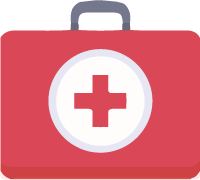Prevent Mold Poisoning and Illness if Symptoms Appear.
- The symptoms of mold exposure in humans can have severe consequences;
- Molds favor paper, cloth, and wood, but could infest concrete and glass too;
- Toxic fungi thrive inside walls, carpets, heating, ventilation systems and more;
- Mold allergies and poisoning pose threat to adults, children, and pets;
- Toxic fungi can grow anywhere as long as conditions are right.

The worst case scenario is toxic mold exposure.
But can exposure to mold cause illness you may ask?
It sure does!
If you sense the slightest sign of a musty odor or see indications of surface discoloring, it could be a sign of an infestation. If you sense a musty smell, you might be exposed to toxic fungi, even if you can’t spot the signs of such growing!
“The term ‘mycotoxin’ is reserved for the toxic chemical products produced by fungi that colonize crops. One mold species may produce many different mycotoxins, and several species may produce the same mycotoxin.”
– Wikipedia
Short-term poisoning from fungi fumes causes adults, children, and pets to suffer from the symptoms of toxic mold exposure. Long-term leads to the development of the mold-linked syndrome. – MoldBlogger.com
How to Figure if Mold Exposure is the Cause?
- Do stale, fusty and stuffy odors bother you?
- Do you inhabit an abode with discolored surfaces?
- Has your roof been leaking?
- Has your home been flooded?
- Have you noticed signs of previous water damage?
- Do you suffer from chronic shortness of breath and weakness?
- Do you experience a chronic migraine?
- Do you experience frequent flu-like symptoms?
- Have you had sinus irritation?
- Have you had ear infections?
- Do you suffer from recurring respiratory difficulties?
- Does your suffering get worse on a rainy day?

If you recognize any of these signs,
you could be a victim of the damp building effect.
What are the Symptoms of Toxic Mold Poisoning?
Look for the top signs of toxicity and mold illness such as shortage of breath, sinus infections, bronchitis, pneumonia, migraines, sore throat, depression, joint pain and inflammation, exhaustion and various digestive problems. Here is a list of the top symptoms associated with mold-associated illness:
- Extreme tiredness and physical exertion;
- Headaches – slight to ice pick pain and severe migraines spikes;
- Sight irritation – red eyes, blurred vision, and photophobia (light sensitivity);
- Ear infections and irritation;
- Disorientation, static shocks, and panic attacks;
- Deficient memory and difficulties with speech;
- Lack of focus and decreased learning ability;
- Morning stiffness, muscle cramps, and increasing joint pain;
- Slight prickling or stinging sensations;
- Sinus congestion, chronic cough;
- Shortness of breath and other respiratory difficulties;
- Mood, body temperature, and appetite swings;
- Vertigo, lightheadedness and poor concentration;
- Joint and abdominal pain, numbness;
- Tearing and a sense of a metallic taste;
- Frequent urination and thirst;
- Diarrhea, bloating and if severe – vomiting;
- Increased sweat (especially at night);
- Skin rashes and even a bleeding nose or bloody cough.
There are 3 levels of mold exposure:
* Do you have any other suggestions? Let us know in the comments!
What could be a False Symptom of Mold Exposure?
If you are ill, you may not immediately consider the cause to be decreased fungitoxicity. Spores and mycotoxins pose health risks of mold illness in humans but that’s not always the case. A few extra comments on the side effects of toxic molds on humans:
- Skin rashes: You may think that skin can only become inflamed by direct contact with toxic mold but this isn’t always the case. You can develop redness in your skin simply from inhaling the fumes of fungi.
- Eye irritation: In springtime, red eyes, blurred vision and photophobia could be mistaken for an indication of allergies when the real cause is a symptom of toxic mold growing in your home or office.
- Chronic tiredness: Enough sleep but still tired? Feeling down for several days in a row, even when you are getting adequate sleep, can and often is a sure symptom of exposure and ongoing infestation.
- A sore throat: Do you experience a raw feeling when you swallow, or hoarseness when you speak? Both symptoms of exposure are indicative of the presence of mold. Spores can lodge in your throat and thus irritate the sensitive membranes within.
- Shortness of breath: Breathing in mold spores can cause a wide range of respiratory difficulties. This is especially prevalent if you suffer from allergies. If exposure is continuous, you may develop asthma or may have asthma and not realize that attacks are being triggered by fungi.
- A runny nose or sinuses: If you are constantly reaching for a tissue to ease your runny nose, it could be a strong symptom of exposure to fungus. Your runny nose could be triggered either by an allergy to fungi spores and fumes. Nose membranes can be easily irritated by the mycotoxins. In either case, you could misdiagnose yourself as having a light cold or seasonal allergy. If your runny nose persists, you should look into the possibility of toxic mold exposure.
- Bleeding nose or caught: Although this symptom is rare, it does occur. Some patients are sensitive to certain allergens and those offending irritants can cause severe reactions. One of those could be nose bleeding caused your nose membranes being damaged by mycotoxins or spores. If this is happening to you, it could be due to toxic mold growing in near proximity.
* Do you have any other suggestions? Please let us know in the comments.
 Important:
Important:
The symptoms of mold exposure are not distinctive and lack definitive indicators. Certainty requires professional inspection and such is recommended whenever in doubt. When sight and scent are insufficient, air and surface sampling are the one sure way to make sure if mold is the source of any symptom.
Do You Suffer from Symptoms of Mold Exposure?

If you have one, several or all of the above-listed symptoms on a regular basis, it is highly advisable that you inspect your home for signs of a fungi infestation. You should track how and when your symptoms occur, worsen and disappear.
When leaving your abode in the morning, do you notice if you feel better during the day, being outside of your abode? This can be a clear indicator that something in your home is, in fact, causing your distress.
The same applies when you’re traveling or on a vacation. If you find yourself in better health then further inspection for the presence of toxic fungus in your property is a must. Your home shouldn’t make you sick and to locate, treat and remove the mold problem is the one and only solution.
How to Treat the Symptoms of Mold Exposure?
- Leave the contaminated area as soon as possible. Moving forward with any treatment without removing yourself and your family away from the infested area is a no-no.
- Get rid of all infested. Throw potentially infested possessions made out paper, clothing fabric, wood and etc.
- Use binders. Binders include oat hulls, clay, wheat bran, charcoal, cholestyramine, cellulose, pectins and yeast cell walls or consult a professional for the right product for your specific circumstances.
- The Shoemaker protocol resembles climbing a stairway. It is an off-label bile that lines-up agents to reduce the effects of mycotoxins in mold-infested properties. For some, the one step required would be to simply leave the infested environment behind. The number of steps depends on how advanced your illness is. It is an efficient solution for cholestyramine powder or prescribed Welchol.
- Other solutions are Upgraded Coconut Charcoal and GI Detox. These products merge toxins in the abdominal tract. Combine those with Glutathione Force to help glutathione. It is a compound involved as a coenzyme in oxidation for patients with toxin-caused conditions.
- Medical care is mandatory to prevent fungi and bacteria colonies from growing and spreading. The most susceptible areas of the human body are your sinuses, gastrointestinal tract, bladder and for ladies – genitalia. Examine yourself and take precautions to prevent excessive growth of candida. A mold-infested environment weakens your immune system thus allowing candida to thrive.
- Intensify the detox abilities of your body.A few of the most effective supplements to boost detoxification after mold sickness are liposomal glutathione, boron, milk thistle, iodine, n-acetylcysteine, alpha lipoic acid, glycine, glutamine, taurine and of course fresh and healthy vegetables;Methylation support is crucial and requires optimal levels of B12 (methylcobalamin), B6 (methyl-folate), riboflavin, and minerals.
- Use a quality air purifier. It is not a solution but it could reduce toxicity levels in the environment and thus reduce the symptoms to mold exposure.
- Cut on foods that contain mycotoxins. These include corn, wheat, barley, peanuts, sugar cane (fungi love carbohydrates), rye, sorghum, cottonseed, hard cheeses, and alcoholic beverages such as wine and beer. A few more to name: oats, rice, tree nuts pistachios, brazil nuts, chiles, oilseeds, spices, black pepper, dried fruits, figs, coffee, cocoa, beans, and bread.
- Keep the normal function of your intestines and prevent constipation. Use magnesium citrate, vitamin C, laxatives, purgatives or aperients.
* Do you have any other suggestions? Please let us know in the comments.
Constipation is a sole enemy of removing toxins out of your body.
What is the treatment for exposure to toxic mold?
If caught on time, you could treat the symptoms and prevent illness.
- Mold-free diets – paleo and grain-free diets show great results;
- Allergy shots (subcutaneous immunotherapy or SCIT);
- Anti-mold herbs and medications;
- Saunas using infrared wavelengths;
- IV nutrient & detoxification therapies;
- Intravenous Immunoglobulin (IVIG): Immune Disorders Treatment.
Build a “safe” room. Equip it with proper filtration to minimize the risks of the presence of toxic fumes, spores or mold-induced allergens.
What are the Effects of Molds on Human Health?
Exposure to toxic mold can be fatal but not all fungi are bad.
Before we further elaborate on the negative effects of toxic molds on human health, let’s begin by mentioning a few positive impacts:
- Rhizopus is a type of fungus that releases fumaric acid. It is used to produce a type of local anesthetic for adults, known as cortisone;
- Aspergillus flavus on the other hand, has been safely used in China for centuries in the making of cheeses and soy sauce;
- Penicillium has led to the discovery of the antibiotic.
However, not all types of mold are as benevolent as the ones above.
Besides looking unsightly, any type of mold can become a major inconvenience once it enters your household or office.
If the infested area is not sterilized in time, the fungi will release numerous spores into the air. Once inhaled by humans, spores can trigger an allergic reaction. The signs of mold toxicity will vary depending on your age, the level of exposure, and your health condition.
Toxic mold is a source for microbial volatile organic compounds (MVOC). Most lack odor but some are quite fusty. In the indoor environment, human exposure to fungal MVOC’s has been pointed as the cause of headaches, nasal irritation, dizziness, fatigue, and nausea. However, the evidence is insufficient, and other factors should also be taken into consideration.
Here is a chart to highlight the most common binders and sources associated with mycotoxins:
| Mycotoxin: | Associated Molds: | Examples Binders: | Potential Sources: |
| Aflatoxin | Aspergillus flavus; Aspergillus parasiticus; | Clays (bentonite, montmorillonite) Charcoals; Zeolites; Glucomannan; Diatomaceous earth; | Milk, cheese, eggs, meat (contaminated feed), cereals, wheat, spices, tree nuts, peanuts, pistachios, Brazil nuts, chilies, oilseeds, corn, spices, black pepper, dried fruit, figs, dried coconut |
| Ochratoxin | Aspergillus albertensis; Aspergillus alliaceus; Aspergillus auficomus; Aspergillus carbonadus; Aspergillus niger; Aspergillus ochraceus; Aspergillus sderotiorum; Aspergillus sulphurous; Aspergillus wentii; Penicillium nordicum; Penicillium viridicatum; | Cholestyramine; Zeolites; Glucomannan; Diatomaceous earth; | Cereals, wheat, corn, oats, coffee, dried fruit, wine, beer, cocoa, nuts, beans, peas, bread, rice, cheese, meats (contaminated feed, especially pork and poultry), dried and smoked fish, soybeans, garbanzo beans |
| Trichothecene | Penicillium verrucosum; Cephalosporium; Fusarium; Myrothecium; Stachybotrys; Trichoderma; Tdchothecium; Verticimonosporium; | Clays (bentonite; montmorillonite); Charcoals; Zeolites; Glucomannan; Diatomaceous earth; | Grains, cereals, wheat, barley, oats, corn, rye, durum, soybeans, potatoes, sunflower seeds, peanuts, bananas |
* This chart is a partial listing of fungi that may produce mycotoxins. Additional sources of mycotoxins or binders may not be present. Some of the binders listed are from veterinary literature. Mycotoxins are crucial for the manufacturing of animal products such as milk, eggs, and meat.
Symptoms of Toxic Mold Exposure – Conclusion and Takeaways:
The signs of mycotoxin exposure are various and often neglected. Many fail to recognize the symptoms of exposure to mold in humans until sickness arises. Mycotoxins cause serious damage to both your health and that of your beloved ones. To be well-aware and detox is how you can prevent the consequences of poisoning and illness in the first place. In case you have suspicions but you can’t see the signs – you should always seek professional help.











6 comments
Recently doagnosed 1.5 years toxic mold exposure. My own home water leak. Moldtteated. HVAC not cleansed, subfloor not removed by mold remediation company. Very I’ll with many symptoms. Trying to learn all I can.
I’ve move in to a new flat in south Croydon and it smells musty all the time. Been coughing a lot lately and tired all the time. Should I call it on the landlord or should try to test it myself??
Hello Ellie,
Your symptoms sure sound like it mold might be the cause but still, it could be due to polluted air, bad habits and God knows what else. Are there any discolored areas within the property? Look out for areas less ventilated
“Hi,
You did a piece of great information about mold exposure symptoms. Some folks didn’t know what will happen if they continue to expose themselves from molds. Anyway, thank you for sharing your post with us this gives an insight to me, I also found this helpful post perhaps it might help, check this out https://nucific.com/mold-exposure/“
I see like in the bathroom wet spots that when dry turn black. Vet said was nematodes but I’m not convinced. Had AC on a board that was infested with mold I have every symptom noted plus coughing up little tiny fish egg like consistency if let dry it becomes fiber like
I have had pneumonia several times in the past ive years so my lungs have been compromised as a result. I sensed there was a mold issue in the apartment building I live in, but there was no “smell” (I tend to be a very clean individual but even still, I could smell nothing).
Over the years (5) various people in the building (only 5 units) had “water issues” (broken pipes, leaking toilets etc). Fans were used to “dry” things out. My turn came – the hose to the toilet tank (water intake) broke. To cut to the quick, for a year or better (since last pipe break in other apt); i’ve suffered chronic fatigue, mood swings (depression); runny nose; watery eyes (I did go through a sneezing jag for a couple of months but it dissipated).
Aches and pains in my body worsened. Naturally, I blamed something in myself wrong; test results (blood and urine), chest x-ray etc all came out fine.
I thought I was losing my mind; fatigue still plagues; runny nose, watery eyes, but the scariest part of all – my breathing. I was given inhalers and told that it was likely COPD (damage due to all the times I had pneumonia over the years). It became humbling (in public, especially with COVID-19 (people automatically asssumed worst – understandably) and it also became frightening. Was the next breath going to come? Would my heart be able to take this as breathing became increasingly worse?
Yes, I am also an older woman, so imagine how one might easily blame the bouts of pneumonia in my recent history, as well as “aging” on the symptoms suffered. Prayer works. Certified remediation and restoration experts came as friends and discovered live mold under flooring from the toilet hose that burst. It’s been a long battle trying to get the landlord to act, but finally they are. I’m moving but eveything fell into place when a prayer of desperation went forth.
I would like to thank the author of this article for the careful research and detailing given in this piece of writing. Guaranteed you have helped many people realize that they are not “crazy” or “imagining” things, after all. Symptom after symptom lined up, not only for an elderly person, but one with compromised lungs.
After a wild, unpredictable storm, there is light glimmering behind the dissipating dark clouds. Thank you for your heart to help others, the time you took researching, as well as the time in organizing all the information into a well-written article. From my heart, thank you!